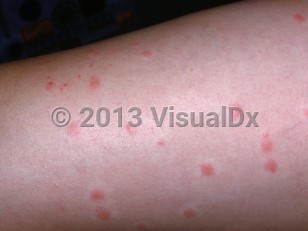Cercarial dermatitis in Child
Alerts and Notices
Important News & Links
Synopsis

Swimmer's itch, also known as cercarial dermatitis or clam digger's itch, is an allergic dermatitis to the abortive penetration into the skin by cercariae of mammalian and avian schistosomes (Trichobilharzia and Bilharziella) after exposure to water containing the intermediate snail hosts. The schistosomes may cause an immunological reaction in the form of cercarial dermatitis in individuals who have been sensitized to the schistosomes.
There is a worldwide distribution, with human schistosomes more common in tropical climates (most commonly Schistosoma mansoni and Schistosoma hematobium).
Swimmer's itch typically presents as a pruritic rash on skin 24 hours after exposure to water containing cercaria in endemic areas. The cercariae enter the stratum corneum and die within hours. The rash is associated with moderate pruritus that is self-limiting but may persist for several weeks. Some patients may develop a delayed rash several days after initial exposure.
Cercarial dermatitis may become more severe with repeated exposure. Patients may develop edema, papulovesicles, and intense pruritus.
Rare presentations have been reported on the upper extremities after cleaning fish tanks.
There are no age or sex predilections.
There is a worldwide distribution, with human schistosomes more common in tropical climates (most commonly Schistosoma mansoni and Schistosoma hematobium).
Swimmer's itch typically presents as a pruritic rash on skin 24 hours after exposure to water containing cercaria in endemic areas. The cercariae enter the stratum corneum and die within hours. The rash is associated with moderate pruritus that is self-limiting but may persist for several weeks. Some patients may develop a delayed rash several days after initial exposure.
Cercarial dermatitis may become more severe with repeated exposure. Patients may develop edema, papulovesicles, and intense pruritus.
Rare presentations have been reported on the upper extremities after cleaning fish tanks.
There are no age or sex predilections.
Codes
ICD10CM:
B65.3 – Cercarial dermatitis
SNOMEDCT:
187115002 – Cutaneous schistosomiasis
B65.3 – Cercarial dermatitis
SNOMEDCT:
187115002 – Cutaneous schistosomiasis
Look For
Subscription Required
Diagnostic Pearls
Subscription Required
Differential Diagnosis & Pitfalls

To perform a comparison, select diagnoses from the classic differential
Subscription Required
Best Tests
Subscription Required
Management Pearls
Subscription Required
Therapy
Subscription Required
References
Subscription Required
Last Reviewed:12/17/2018
Last Updated:01/09/2019
Last Updated:01/09/2019

